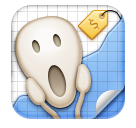
Sticker Shock FAQ
Here you'll find the answers to the most commonly asked questions about Sticker Shock.
What is Sticker Shock?
Sticker Shock is a price tracking app used to measure the price inflation you're experiencing in the things you buy on a regular basis.
How do I set up Sticker Shock?
Sticker Shock comes pre-loaded with a few commonly purchased items. Tap the Info button on the main screen to edit this list of items. Delete any of these that you never purchase or don't wish to track. Next, add the items that you do wish to track. These can be anything at all that you purchase, but will typically be things that you purchase multiple times throughout the year. For example, anything from a grocery store, home improvement warehouse, or restaurant will work well.
How do I use Sticker Shock?
It's very simple. Whenever you purchase an item that you're tracking (or even just notice the price somewhere), tap the item on the main screen, then tap the “Add new price” button. Enter the price and tap the “Done” button. That's all there is to it. If you're entering historical prices you can tap the “Date” button and specify a past date before tapping “Done”.
What exactly are the Units?
The Units field is provided to help you remember precisely what it is you're tracking, i.e a gallon of gas, a lb of ground beef, a large 2-topping pizza, etc. You can put anything you want here. If you're tracking food products that list a “unit price” it is advisable to track that, rather than the actual cost. That way when manufacturers attempt to conceal a price increase by reducing the package size you won't be fooled.
What is the “overall change” on the main screen?
Sticker Shock averages the inflation rates of all items and displays your overall price inflation rate. Think of it as the rate of change of your own Personal Price Index, a measure of the price inflation you're experiencing in your own life, based the things that you actually buy.
How do I view the overall price inflation for a particular category?
While viewing the main screen, tilt your iPhone into landscape mode. A larger version of the overall price inflation graph will fill the screen. This graph contains a category button, defaulting to “All Categories”. Click this button to select a category. The graph will be updated to display the overall price inflation for all items in the selected category.
What is ult?
It's the abbreviation for ultimo, Latin for “last month”.
How are items weighted in my overall inflation rate?
Items are weighted according to the “Purchases per year” estimate.
Items with a zero estimate are weighted equally. Thus, if you are tracking three items with price inflation rate A, B, and C, the overall price inflation rate would simply be (A + B + C) / 3.
For items with a non-zero “Purchases per year” estimate, the weighting is determined by the estimated annual expenditure, that is, purchases per year times price.
So for items A, B, and C, with annual expenditure (a), and price inflation rate (i), the calculation would be:
total annual expenditures (t) = A(a) + B(a) + C(a)
number of items (n) = 3
weighted A component = A(i) * ( 1/n * (A(a) / t))
weighted B component = B(i) * ( 1/n * (B(a) / t))
weighted C component = C(i) * ( 1/n * (C(a) / t))
overall price inflation rate = sum of all components
Can I estimate purchases per year for some items, but not others?
Yes, any items with a zero estimate will receive a weighting equal to the reciprocal of the total number of items. For instance, if there are ten items, and six of them have a zero estimate, then these six items will account for 60% of the overall price inflation rate, or 10% each. If the other four items have an estimate, they will account for the remaining 40%, individually weighted according to the formula described above.
Are you sure about this methodology?
It makes sense to us. Drop us a line if you think it could be improved.
Why would I want to track prices anyway?
Well, you'll have to answer that for yourself. For us, we got tired of being at a store, any store really, grabbing something off the shelf, and being… you guessed it, shocked by what it cost. And as always we didn't remember what it used to cost. Or when. We just knew it didn't used to cost this much! Now, with Sticker Shock, we can keep a precise record of how we're being affected by the relentless rise in food and energy prices.
What currencies do you support?
Here's the current list. If you need anything added just ask.
Argentina peso
Aruba florin
Australia dollar
Bahrain dinar
Brazil real
Brunei dollar
Canada dollar
Chile peso
China Renminbi yuan
Columbia peso
Costa Rica colon
Czech Republic koruna
Denmark krone
Egypt pound
European euro
Great Britain pound
Honduras lempira
Hong Kong dollar
Hungary forint
Iceland krona
India rupee
Indonesia rupiah
Isle of Man pound
Israel new shekel
Jamaica dollar
Japan yen
Kazakhstan tenge
Korea won
Kuwait dinar
Malaysia ringgit
Mauritius rupee
Mexico peso
Nepal rupee
Netherlands Antillean guilder
New Zealand dollar
Norway krone
Oman rial
Pakistan rupee
Philippines peso
Qatar rial
Russia ruble
Saudi Arabia riyal
Singapore dollar
South Africa rand
Sri Lanka rupee
Sweden krona
Switzerland franc
Taiwan new dollar
Thailand baht
UAE dirham
Ukraine hryvnia
United States dollar
Venezuela bolívar fuerte
Viet Nam dong
Zimbabwe dollar